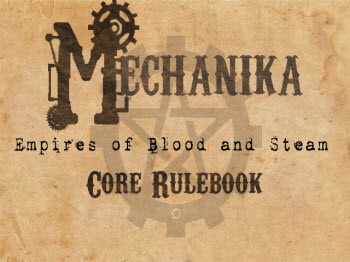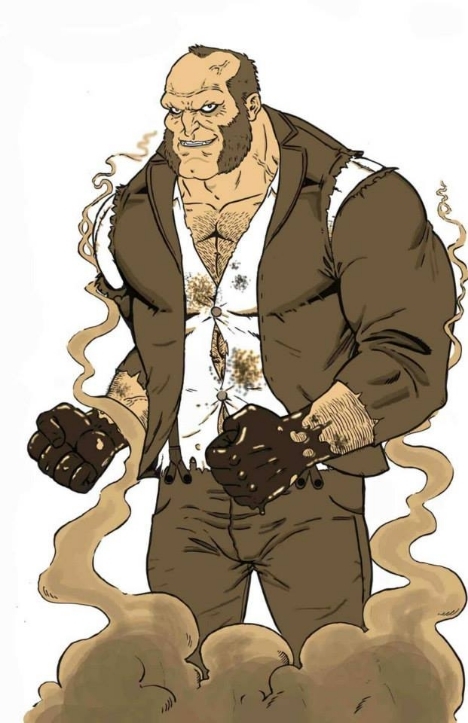 Mechanika: Empires of Blood and Steam is currently in its final days on Kickstarter, and it has been a clear success, a success that comes in no small part from its writer and designer, M. P. Yorty. Above all else, M. P. Yorty is passionate about game design. “We want to make good games for good people,” he told me during our interview. “I think that is our motto. Good people deserve good games.”
Mechanika: Empires of Blood and Steam is currently in its final days on Kickstarter, and it has been a clear success, a success that comes in no small part from its writer and designer, M. P. Yorty. Above all else, M. P. Yorty is passionate about game design. “We want to make good games for good people,” he told me during our interview. “I think that is our motto. Good people deserve good games.”
The lead designer and writer for the upcoming role-playing game Mechanika: Empires of Blood and Steam, M. P. Yorty has been working in the game industry for years. He has written for White Wolf Publishing, working on the Dark Ages line for the World of Darkness and Demon: the Fallen. A freelance writer, he has been one of the driving forces behind Mechanika and the new system it is bringing to the market: Xaos. An avid fan of steampunk and Lovecraft, Mechanika and the Xaos System has been a labor of love and inspiration.
The origins of the Xaos system came five years ago, during a session of a Pathfinder game. While many at that table were experienced hands at tabletop roleplaying, a player new to the hobby noticed something about the game that Yorty agreed with. “She pointed out how the barbarian had been stabbed over eight times . . . and how unrealistic that was. It pulled her out of the game.” To him, it was a moment that crystallized the need for an action roleplaying game with mechanics that served to enhance the cinematic storytelling of tabletop gaming, rather than conflicting with it. Already familiar with the use of Fudge dice from both its own system and other models (such as Fate Core or Dresden Files), Yorty and his fellow designers went to work crafting a new game using the Fudge dice. This game would become the Xaos system.
Mechanika: Empires of Blood and Steam itself began three years ago during PAX. M. P. Yorty had noticed a lack of steampunk games on the market, and one of his friends purchased one at the convention. They sat down to steep themselves in the rules and gameplay, but they were ultimately disappointed with it. “I realized that there was a need for a good steampunk game,” explained Yorty. “I wanted to make a game where you could, literally, play anything you wanted . . . [In Mechanika], you can play whatever you can imagine.” Rather than building a whole new universe for his game, Yorty chose instead to set his game in a world at once both familiar, yet amazing. The decision to make Mechanika an alternate Earth came early on, with earlier versions of the game being more closely inspired by history. This led to some problems in playtesting, as a player’s ignorance of history’s lesser known figures could stand in the way of immersion in the narrative.
To fix this, Yorty began incorporating elements of well-known fiction to enhance the narrative. This change gave Mechanika enough to be familiar to anyone, with the level of history and fiction able to find its own balance in any given play group. The incorporation of fictionalized characters into the world of Mechanika served to enhance the history as well. “Nikola Tesla has been influenced . . . by the works of [Victor] Frankenstein,” explained Yorty, while the Isle of Dr. Moreau is a result of Napoleon’s exile and “the source of a new race”. Captain Nemo and the Nautilus provide access to the ruins of lost Atlantis; Rasputin was resurrected after his assassination by the power of Tesla’s science; Edison’s business acumen has changed that world’s United States.
The works of H. P. Lovecraft are also featured heavily in Mechanika, influencing every aspect of the game. The looming threat of the great and terrible Old Ones is present throughout, and it moves the story out of the safe waters of simple morality often found in fantastic settings. “Everything should be [morally] grey,” explained M. P. Yorty, calling upon Lovecraft himself as the source of this ambiguity. The entities of Lovecraft’s mythos are too alien to be evil, too destructive to be good, and too inhuman to be truly knowable. Even the seemingly benevolent character of the Traveler in Mechanika is kept from being easily classified. “He is not a good guy. He tries to help people, but [the results] all depends on which side you are on.”
M. P. Yorty does not plan on stopping at the release of the core book for Mechanika: Empires of Blood and Steam. “Mechanika will be a complete game, with over 450 pages of content,” he offered. “However, it is the start of a whole line of products.” For Mechanika, there are plans for a Metalized game master screen and kit, with a chalk board for notes. A serialized module set is planned as well, continuing the adventures of the crew introduced in the demo currently available on their website. Next year, there are plans to release a Monstrous Manual for Mechanika. There are even tie-ins planned with Chessex for Mechanika specific dice sets, and a plan for a new Kickstarter for a line of Mechanika sodas and beers. There are plans for two more games to be produced using the Xaos system as well, with a “space western” planned for 2015 as well as a post apocalyptic setting for release after that.
 Mechanika will be a tough act to follow, as it stands to be one of the more comprehensive game settings and systems. The goal of Mechanika was to create a game that was balanced, yet expansive. “Build what you want to play . . . There are no classes or levels. Want to play a werewolf? We have a perk for that.” The base game itself features a wide range of character options, with several different playable races, a wide array of Perks and Flaws, a selection of Skills and specialties, and an exhaustive set of options for magic users and inventors.
Mechanika will be a tough act to follow, as it stands to be one of the more comprehensive game settings and systems. The goal of Mechanika was to create a game that was balanced, yet expansive. “Build what you want to play . . . There are no classes or levels. Want to play a werewolf? We have a perk for that.” The base game itself features a wide range of character options, with several different playable races, a wide array of Perks and Flaws, a selection of Skills and specialties, and an exhaustive set of options for magic users and inventors.
“Magic is powerful and always dangerous,” warns M. P. Yorty. “Sometimes, it’s just better to shoot something with a revolver.” With a dozen schools of magic to offer, and three separate approaches, no two spellcasters play the same. Every spell has a risk to it, capable of harming a caster’s mind, body, or soul. Inventors also have seven Houses of engineering to choose from, with methods to either devote their character to personalized gadget creation or to simply dabble with pre-built devices and batteries. Flux, the fuel used for both magic and artifice, is inherently unstable, with the devices of Mechanika being susceptible to breaking, or worse, malfunctioning in dangerous ways.
Mechanika has been extensively playtested, with 38 groups having submitted over 1600 feedback forms critiquing the system, setting, and game. While each game distinctly developed its own style of Mechanika, M. P. Yorty was pleased to see several trends emerge. “[We] had 17 steampunk Tony Starks among our playtest groups,” he offered proudly, with the human hardboiled detective emerging as another common character. He also described a group whose game had focused almost entirely on political and social intrigue, having featured, to date, only one combat. Mechanika has proved itself through these playtests to be a flexible game capable of handling action and intrigue in both hands, while never straying too far from the root of cosmic horror.
While the road to Mechanika: Empires of Blood and Steel has not been an entirely smooth one, M. P. Yorty and his design staff have taken advantage of the challenges put before them. When an earlier Kickstarter attempt failed to reach its goals, Xaos Publishing leveraged their contacts and experience to increase their chances of a successful relaunch. They were able to better explain their costs and bring a better product to the table the second time around. Their Kickstarter’s success promises to bring Mechanika to both its existing fans and soon-to-be converts in all of its Do It Yourself glory. It is only fitting that a game founded on the idea of playing the game you want to play should succeed through crowdfunding.
“Good people deserve good games.” With a motto like that, Xaos Publishing is in excellent hands with M. P. Yorty. While there are a growing number of steampunk games coming to the market, Mechanika: Empires of Blood and Steam brings the passion, experience, and uniqueness to gain the traction necessary to pull itself above the fray. I am looking forward to its success.
